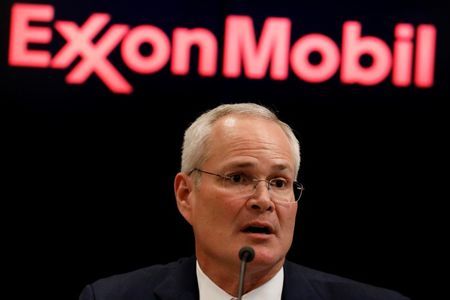
By Ernest Scheyder and Erwin Seba
HOUSTON (Reuters) – Exxon Mobil Corp Chief Executive Darren Woods is reorganizing the company’s refining and chemical operations, part of a push to boost profits amid volatile oil and natural gas prices, a spokeswoman said.
The changes at the world’s largest publicly traded oil producer are the most sweeping to date by Woods, who became chief executive in January after former chief Rex Tillerson resigned to become U.S. secretary of state.
Woods has moved first to reshape the businesses he knows best, according to sources familiar with the matter. Before taking the helm at Exxon, Woods ran Exxon’s refining operations and earlier in his career was a senior executive in its global chemicals unit.
The reorganization aims to squeeze more profits from the fuel and chemicals businesses as the company works to improve its exploration and production operations, which have struggled since 2014 to adjust to lower oil and gas prices.
The restructuring, disclosed internally last month, will combine the fuels and lubricants division with the supply and refining divisions.
Financial responsibility for the merged operation will rest with country and regional chiefs who report to Exxon’s Irving, Texas, headquarters rather than divisional bosses as previously, according to people familiar with the matter.
The changes are designed to simplify operations and increase accountability for profitability, the sources said.
Exxon spokeswoman Charlotte Huffaker confirmed the overhaul in a statement, adding the company expects it will “improve decision making and enhance performance in the market.”
It was not immediately clear if the changes will involve job cuts or executive departures. Huffaker said she could not say if there would be any impact on jobs.
REFINING STRENGTH
Exxon’s refining and chemical operations have grown in stature under Woods, delivering steady earnings compared to its oil and gas production.
Exxon operates 22 refineries in 14 countries, processing nearly 5 million barrels of oil per day. The firm builds chemical and refining plants in the same location, allowing managers to shift production between fuels or chemicals based on demand.
The changes come as Exxon expands the refining division. The company is investing $20 billion through 2022 to expand its chemical and oil refining plants on the U.S. Gulf Coast.
The refining and chemicals arms contributed more than $4.2 billion apiece to 2016 earnings, compared with a $196 million profit from exploration and production. Last year’s results were affected by sharply lower crude prices.
In some quarters, Exxon would not have made any money were it not for its refineries.
This year, the company’s oil and gas business bounced back to a $5 billion profit during the first nine months on stronger crude prices. Refining earnings were $4.03 billion and chemicals $3.25 billion, respectively, for the first three quarters this year.
Some staff members have raised questions as to whether there is any need to alter a system seen as largely successful, said the sources who declined to be identified.
It was unclear if the changes would impact an internal accounting practice known as general interest principle. That rule permits certain transactions to be loss-making for a local division if they are beneficial for the corporation as a whole.
Exxon did not comment on any potential accounting changes.
